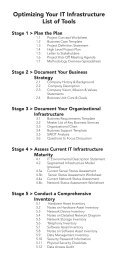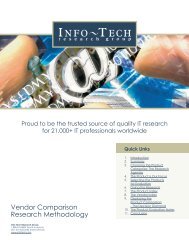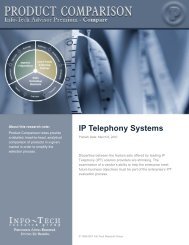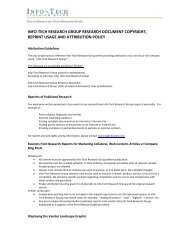Top 10 Energy-Saving Tips for a Greener Data Center - Info-Tech ...
Top 10 Energy-Saving Tips for a Greener Data Center - Info-Tech ...
Top 10 Energy-Saving Tips for a Greener Data Center - Info-Tech ...
Create successful ePaper yourself
Turn your PDF publications into a flip-book with our unique Google optimized e-Paper software.
Future data centers will require considerably more power and cooling capacity than is available in mostexisting environments. According to both The Uptime Institute and HP Labs, the heat density of datacenters is currently increasing at a rate of about 15% to 20% per year. As devices get smaller, faster,and cheaper, enterprises are packing more machines into rooms that were not designed toaccommodate the increased cooling burden. So, even though individual devices may produce less heat,the aggregate number is driving up cooling requirements and energy consumption.As an example, data centers three or more years old housed racks that consumed 5 kW to <strong>10</strong> kW ofelectricity or less. However, newer racks are easily in the range of 20 kW or more. According to IBM,some high-density server racks (such as blades) draw as much as 30 kW of power. This translates intoan annual per-rack power and cooling cost of between $35,000 and $60,000, depending on theefficiency of the data center.Since both heat density and computing requirements are growing, but server rooms are most likely notexpanding, heat density will increase not only at the rack level, but also over the entire room. Manyexisting server rooms were designed based on an assumption of an average heat load (across the room)in the range of 40 to 70 watts per square foot (W/ft 2 ). These data center environments are not equippedto handle heat loads being generated by many of the newer high density racks that can boost powerdensity to 300 W/ft 2 or more.Rising heat density is inevitable and not necessarily something that is within the enterprise’s control.However, knowing heat densities and identifying heat concentrations <strong>for</strong> various areas is necessary inorder to deploy the appropriate cooling strategy. Higher heat densities also require more coolingredundancy because denser systems increase in temperature much faster, thus reducing the windowduring which cooling systems can be offline.Standards are ComingWith standards and ratings, IT decision makers will be able to make better purchasing decisions andbetter evaluate products based on an energy-inclusive TCO analysis. While vendors and industryregulators are still a bit behind on the power and cooling issue, they are catching up. Several parties inthe US, including the Standard Per<strong>for</strong>mance Evaluation Corporation (SPEC), the EnvironmentalProtection Agency (EPA), and the US Legislature have recently begun to evaluate server energyefficiency metrics in an attempt to create standards.The US Senate and House of Representatives recently passed bills (House Bill 5646 and Senate Bill3684 respectively) that promote data center energy efficiency. The SPEC (which includesrepresentatives from AMD, Dell, EMC, Hewlett-Packard, Intel, IBM, Oracle, Sun, and many others) isahead of the game and has already begun publishing some preliminary benchmarks.Operate & Optimize 5<strong>Top</strong> <strong>10</strong> <strong>Energy</strong>-<strong>Saving</strong> <strong>Tips</strong> <strong>for</strong> a <strong>Greener</strong> <strong>Data</strong> <strong>Center</strong>







